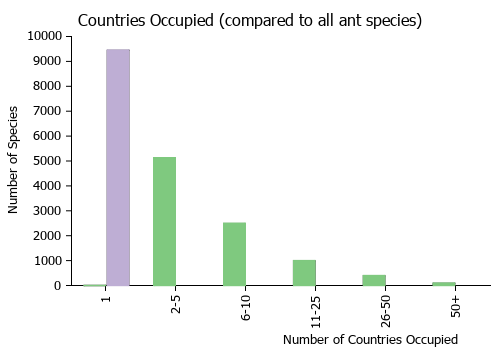Strumigenys radix
| Strumigenys radix | |
|---|---|

| |
| Scientific classification | |
| Kingdom: | Animalia |
| Phylum: | Arthropoda |
| Class: | Insecta |
| Order: | Hymenoptera |
| Family: | Formicidae |
| Subfamily: | Myrmicinae |
| Tribe: | Attini |
| Genus: | Strumigenys |
| Species: | S. radix |
| Binomial name | |
| Strumigenys radix Bolton, 2000 | |
Despite their being more than ten collections of this ant, the only recorded biological record is of one specimen being found in open forest.
Identification
Bolton (2000) - Within the Strumigenys emmae-group only this species and Strumigenys anchis have two distinct preapical teeth on each mandible. The latter is immediately separated from radix as the ventrolateral margin of the head of anchis, in front of the eye, has a broad, deep U-shaped concavity. Some samples of Strumigenys emmae have a minute denticle on the inner mandibular margin distal of the spiniform preapical tooth but in those the scapes are much flattened and expanded in their median third, the lateral margins of the postpetiole disc are margined with spongiform tissue in dorsal view (and the disc usually has some sculpture) , and the hairs on the first gastral tergite are sparser and not so strongly expanded apically.
Identification Keys including this Taxon
Distribution
Latitudinal Distribution Pattern
Latitudinal Range: -25.96666667° to -25.96666667°.
| North Temperate |
North Subtropical |
Tropical | South Subtropical |
South Temperate |
- Source: AntMaps
Distribution based on Regional Taxon Lists
Australasian Region: Australia (type locality).
Distribution based on AntMaps
Distribution based on AntWeb specimens
Check data from AntWeb
Countries Occupied
| Number of countries occupied by this species based on AntWiki Regional Taxon Lists. In general, fewer countries occupied indicates a narrower range, while more countries indicates a more widespread species. |

|
Estimated Abundance
| Relative abundance based on number of AntMaps records per species (this species within the purple bar). Fewer records (to the left) indicates a less abundant/encountered species while more records (to the right) indicates more abundant/encountered species. |

|
Biology
Castes
Nomenclature
The following information is derived from Barry Bolton's Online Catalogue of the Ants of the World.
- radix. Strumigenys radix Bolton, 2000: 953 (w.q.) AUSTRALIA.
Type Material
- Holotype, worker, Cooloola, Noosa R., Queensland, Australia, Greenslade,P.J.M., ANIC32-017802, Australian National Insect Collection.
- Paratype, 1 queen, Cooloola, Noosa R., Queensland, Australia, Greenslade,P.J.M., ANIC32-017803, Australian National Insect Collection.
Unless otherwise noted the text for the remainder of this section is reported from the publication that includes the original description.
Description
Worker
HOLOTYPE. TL 1.7, HL 0.47, HW 0.36, CI 77, ML 0.14, MI 30, SL 0.24, SI 67, PW 0.23, AL 0.44. Exposed length of fully closed mandible less than width of anterior clypeal margin. Mandible with two preapical teeth; a long spiniform proximal tooth and an acute conical distal tooth that is about one-third the length of the proximal. Antenna with 4 segments; second funicular segment longer than broad. Cephalic dorsum with broadly spoon-shaped to suborbicular hairs; upper scrobe margin fringed with similar hairs and with a remiform to clavate apicoscrobal hair. Occipital margin of head without erect hairs. Leading edge of scape flattened and very obtusely angled near the midlength, without a convex lobe in the median third of its length. Pronotal humeral hair large, curved remiform; a similar pair present on mesonotum. Ground-pilosity of promesonotal dorsum spoon-shaped. Promesonotal dorsu m finely reticulate-punctate. Disc of post petiole somewhat swollen, entirely smooth; sides of disc in dorsal view not margined by projecting spongiform tissue. First gastral tergite with numerous short thick remiform hairs that are strongly expanded apically. Basigastral costulae at least equal in length to postpetiole disc.
References
- Bolton, B. 2000. The ant tribe Dacetini. Mem. Am. Entomol. Inst. 65: 1-1028 (page 953, worker d*Heterick, B.E. 2021. A guide to the ants of Western Australia. Part I: Systematics. Records of the Western Australian Museum, Supplement 86, 1-245 (doi:10.18195/issn.0313-122x.86.2021.001-245).
- Heterick, B.E. 2022. A guide to the ants of Western Australia. Part II: Distribution and biology. Records of the Western Australian Museum, supplement 86: 247-510 (doi:10.18195/issn.0313-122x.86.2022.247-510).
escribed)

